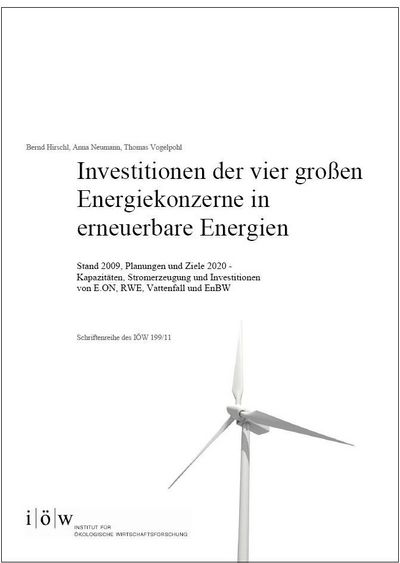Investments of the four major energy companies in renewable energies Status 2009, plannings and objectives 2020 - plant capacities, power generation and investments of E.ON, RWE, Vattenfall, and EnBW
This present study analyzes the power plant capacity, power generation and the investments in renewable energies of the four largest energy suppliers in Germany – E.ON, RWE, Vattenfall, and EnBW – for the year 2009 as well as for the politically relevant target year 2020. It examines the corporate developments in these areas across the group as well as in their core market Germany. The investigation of the companies’ plans for 2020 in their core market Germany, however, was not possible due to the lack of detailed quantitative data for this time frame. The study builds on a previous analysis (Link zur Vorgängerstudie von 2009), which analyzed the corresponding companies’ data for the year 2007. The central starting point for the study is the fact that these data can predominantly still not be read directly from the companies’ publicly available information. Furthermore, the companies’ long-term goals usually do not relate to the politically relevant target year 2020.
Firstly, the analysis of 2009 data shows that no significant changes regarding the shares of renew-able energies in power generation have occurred in comparison to the year 2007. Solely RWE shows a significant increase in this regard, but nonetheless stays in last place with a share of 3.5%. Vattenfall remains at the top position with a share of 22%, which is mainly due to its large hydro-power resources in Scandinavia. The development of the shares of renewable energies in power generation of all four companies significantly lags behind the EU-wide boost to 20%. Deducing the generation from predominantly old hydropower plants and thereby only taking into account new re-newable energy plants, the shares of renewable energies in power generation sink below 2% regarding all of the four companies. In the companies’ core market Germany, EnBW leads with a share of 11%, which is again mainly due to the company’s old water power plants, whereas Vatten-fall shows a share of about only 1%. All four companies lag – in parts significantly – behind the nationwide expansion level of 16% in Germany for the year 2009. The proportions of new renewable energies, i.e. without hydropower, even range between only 0.4 and 1%. Regarding the targets for 2020, all companies plan to increase their electricity production from fossil or nuclear fuels significantly. As a result thereof, the shares of renewable energies of the four companies are envisaged to remain below the political objectives of the EU Commission and the German Federal Government of a share of 35% of renewable energies in 2020. The short to medium term investments of the companies in renewable energies reach a maximum of 20%. In all four companies, the main technological focus of these investments is put on wind energy, particularly on offshore installations.



